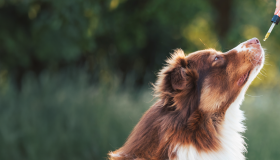
October 15, 2021 – Dr. Kelly Diehl speaks with Dr. Alex Moskaluk about ringworm in cats. They discuss some basics about the disease and then take a deep dive into Dr. Moskaluk’s latest research study.
0:00:11.6 Kelly Diehl: Welcome to Fresh Scoop, Episode 37, Ringworm in Cats. I'm your host, Dr. Kelly Diehl, Morris Animal Foundation Senior Director of Science and Communication. And today, we'll talk with Dr. Alex Moskaluk. Dr. Moskaluk is a veterinary post-doctoral fellow at Colorado State University. So welcome, Alex, thanks for being here. Before we get started, can you tell us a bit about yourself and what led you to veterinary medicine?
0:00:40.5 Alex Moskaluk: Yeah, thank you for having me. So, a little bit about myself. So, I've always wanted to be a veterinarian. The classic story of ever since you were knee-high, you wanted to go to vet school, but I actually come from a family of engineers. And so, when I went to undergrad, I did bio-chemical engineering, and so that switched me over to the research track and getting interested in that, but I still wanted to do veterinary medicine, so I went to vet school at UC Davis, but I had a really strong interest in research and kept pursuing that and so currently I'm finishing up my PhD here at Colorado State University.
0:01:20.6 KD: Great, and when did you get to CSU again?
0:01:24.1 AM: So, I started here in 2018, or about three years now.
0:01:29.1 KD: And for everyone who's listening, Alex confessed to me before we started that she loves fungus, so we'll get into that, but actually tell us why a fellowship in infectious disease?
0:01:41.5 AM: Yeah, so during vet school, I was always really interested in our classes of infectious diseases and viruses and outbreaks, and that was when Zika was also happening, so it was this animal-human interaction. So, the One Health concept. And so that really got me interested, and so I came to do my PhD and I thought I wanted to be a virologist, but then we were looking into what viruses are really infecting shelter medicine, and then one of the diseases that popped up for me was ringworm and it just... We started talking about it and it just completely overtook everything, and it was like fungus were the coolest thing, and so I just really delved into that.
0:02:28.0 KD: So, tell us a little bit about what ringworm is. Most of our audience are a lot of veterinarians and vet students, but we do have people who are members of the lay-public, and I think there's some misperceptions about ringworm. It's a terrible name, right? So, tell us more about what it actually is.
0:02:47.0 AM: Yeah, if I could, I would re-brand it. So what ringworm is? It's a superficial fungal infection. So, what it does is it infects keratinized tissue, so hair, skin, nails. If you got any of that, you can get ringworm, so humans can get it cats, dogs, and any wildlife also. And so, the really big problem with ringworm is it can infect different species, so if a cat gets it, it can shed it, and infect a human or it can infect other cats that are with it or other dogs, and so it's very highly contagious and so once it gets into a population, so for example, a shelter where it's high-density population, it can just spread through the whole shelter.
0:03:31.2 KD: Right, and maybe I have a misperception on this, but when I was in practice, I saw it way more commonly in cats, and is... Then dogs... And is that a misperception? And also how... You just talked a little bit about it, but how do cats get this infection?
0:03:51.1 AM: Yeah, so I think that's more of... For cats versus dogs, I think that's just what populations we have in the United States, so most of the cats that are getting it are strays living out in packs, out in an environment, and so they have a lot more contact with different animals, whereas the US, we don't have a lot of stray dogs populations compared to other countries, so I think that is why we see it more in cats. However, the literature for that is quite lacking on, is it really more cats or dogs or is that just what certain practices are seeing? In terms of how they're getting it, it's from other animals, so as I was saying before, if you have a kitten come into the household, everyone else can get it. They can also get it from the environment, so if you have contaminated surfaces, so hairbrushes, towels, any instruments or something like that, they can get the fungal spores on them, and then those can spread to everyone else.
0:04:52.3 KD: And that brings me to a question I was going to ask you, which is, if we focus on cats, why is ringworm really such a big deal for cats and cat owners?
0:05:05.0 AM: Yeah, so one of the really big problems for cats getting ringworm is they come into the shelter and then they can spread it to everyone there, so the other cats and then the people working with the cats, so it's zoonotic. And so that's a really big problem for the staff that are taking care of these animals. And the other problem is, so once the cat gets ringworm, the amount of work you have to do to treat that, so the treatment hasn't really been updated in a long time for anti-fungals. So, the main treatment for shelters is dipping these cats in lime sulfur, which smells like rotten eggs and it stains everything horrible colors. And so, you have to do that for multiple times until the cat is cured, which can be up to a few months, depending on how much fungal burden they have. And so, if you imagine trying to dip a cat into a lime sulfur bucket, it's not the most fun experience, and so it's also really labor-intensive, and so a lot of the shelters don't have enough resources to be able to handle that. And so, from that, and then also the contagious nature, they're just not able to manage these cases, so unfortunately, sometimes it does lead to euthanasia. Even though it's a treatable disease, it's just not manageable.
0:06:20.1 KD: Right, and I would say probably it impacts their ability to adopt these cats because they know they have a zoonotic disease that they could pass along, so I think that is important. I think most of us as veterinarians, I hate to admit it, but I definitely got ringworm from patients that I saw. I had it as a kid because we had cats and... Can you... I know you're not a human person but talk a... Well, you are human, but you're not... [laughter] A human doctor... But tell me a little bit about... If you know, very quickly, ringworm in people.
0:06:57.4 AM: Yeah, so it's actually quite similar, so there's different species of ringworm that can cause disease, and so for humans, it's based off the location that's in infecting the body. So, for humans, when it's infecting the scalp, so in the hair, it's quite similar to you, what seen in animals because of the fur, and so then they can also get it, so it's also called athlete's foot or any of those terms, it's the same type of organism that causes disease, so it's also contagious. So, you always hear the saying if you go to a pool without shoes on, you could get athlete's foot, and so that's the same mechanism that's happening. And so, a lot of wrestlers and people with a lot of physical contact can get it and spread it really easily, just like animals.
0:07:43.6 KD: Okay. Well, that's really helpful to know. I never thought about the athlete's foot thing too, as far as that... And I know for me when I had ringworm both as a kid and as a vet. Sure, there's topical. And then you can also... It is itself. Eventually, you'll get rid of it. It's just unsightly... [laughter] When you've got it.
0:08:09.1 AM: Yeah, we actually had another fellowship that I was on, I was fortunate enough to go down to the hospital down in Denver where we saw human patients in a dermatology clinic, and unfortunately, some of the patients, if you're immunosuppressed, you have ringworm for decades, because your body just can't fight it off, so it's... In the human medicine side too, it's a big problem, and so also on animals.
0:08:34.2 KD: Cool, let's move to your study. Can you talk a little bit about what you wanted, what your goals are to accomplish with your study?
0:08:44.6 AM: Yeah, so for our study, we have two different aims that we're going for, so one is to develop a new diagnostic assay that's more rapid. So currently right now for diagnosing ringworm, most people do culturing, so you do a fungal culture with your sample, and so that takes a few weeks to get results, because you're waiting for the fungus to grow. You can also do a PCR, which is a DNA-based test. Unfortunately, that's quite expensive, so a lot of shelters can't afford that option, and... So, what we're aiming to do is to develop a novel diagnostic assay that's based off of a protein that the fungus produces during infection, so we're targeting that protein so we know it's an active infection. It's specifically for the organism that causes ringworm. And so, with this assay, we're hoping to be able to, one day turn it into a bedside assay, sort of the SNAP test where you can just put your sample on to it, wait your 15 minutes, and get your results then.
0:09:49.5 KD: Right. And for those of us who are old like me and probably you've seen this, Alex, we used to have you put it in this media and it would turn colors and we would have them stacked on a shelf somewhere, because as Alex mentioned, could take weeks for those results to come back and they were easy, but not very helpful. So, this study is I think so exciting. And why is a study like this important if you're looking big picture? You alluded to it but elaborate on it.
0:10:20.8 AM: Yeah, so the main problem for ringworm is that it's highly contagious, so you want to be able to diagnose it quite quickly and be able to screen the cats that are coming into the shelter. And so, if you're having to wait two weeks for results, by then it could have spread throughout everyone else. And so, we're hoping with this diagnostic assay in the future, once we've optimized it and all of that, be able to offer it as a bedside diagnostic for screening ringworm in patients.
0:10:49.2 KD: So, talk us a bit more in depth, go a little deeper on your methodology and what you're doing. So here comes the heavy science, everyone.
0:11:00.5 AM: So, what we did was the assay that we're doing is an antibody assay, so we created antibodies to this protein that the fungus makes, so we coat our assay with the antibodies, and then we add the sample to it, and if the protein is present, it will bind to the antibody. And then we put a fluorescent tag into it, so that you can tell if the protein is present, you'll get a little color change. And so, it's very similar to a pregnancy test in the SNAP test where if it is there, you'll get the color change in the paper, and so that's what our assay is based off of.
0:11:40.6 KD: Great. And I don't know if you've done very much yet, if you've had a chance, but what are you hoping as far as what would you do next based on the outcome of your study? I was going to ask you a little bit about what you're going to find, but you kind of covered that, so again, what would you do next if this all worked out perfectly well? [chuckle]
0:12:09.3 AM: Yeah, so currently, we've been able to do this with samples that are in culture, so we're able to tell when the peak protein is being expressed. And so, we're going to want to use those results and optimize our assay for clinical samples. And so, then after we get it for clinical samples, we want to make it so it's a consumer product, so veterinarians at shelters can purchase this product and be able to use it bedside with the patient.
0:12:38.8 KD: That would be really helpful. Do you think you'll be able to maybe test it, like you say, clinical samples? Do you have something in mind, or somebody lined up yet that you might work with?
0:12:52.0 AM: Yeah, so we currently are working with multiple shelters across the country. So, for this study, we've been working with a shelter in California, New Mexico, here in Colorado, and then some dermatological practices over in New Jersey and Massachusetts. So, we're trying to get samples from all across the country and from shelters and from derm practices, as those are the ones that are mostly dealing with ringworm cases. Hopefully, after we get this more into the bedside formulation, hopefully I can go to some of the shelters that we're working with already and try them there.
0:13:28.0 KD: It would be awesome, that's an... It'd be a huge boon for them. What other projects are you working on? Is this your only project or you do have some other work that you're doing as well? It doesn't have to be in ringworm, but just in general.
0:13:41.4 AM: Also... Sorry, I completely forgot for... When you asked me what projects I'm working on, I only talk about aim 1. I have two. [chuckle]
0:13:48.0 KD: Oh, yeah, talk about aim two. I completely glossed over that. No problem.
0:13:53.6 AM: I was just getting real excited...
0:13:54.4 KD: Yeah, no. Talk about aim two. Yeah.
0:13:56.8 AM: So, our second aim for the project is to actually look at the different strains of ringworm. So, people have probably been hearing in the news for COVID how there's different strains, or flu, how there's different strains. No one's really looked into are there different strains of ringworm? So, when you have clinical presentation of ringworm, the cats can present with just a little area of alopecia, hair loss, or multiple areas and fully covered with ringworm. And so, it's, is that the host factor or is that actually the pathogen of the fungus factor? And so that's our second aim is to look across the United States at these samples and see are there different strains, and if so, do they correlate with any of the clinical presentations? So is it cats that are strays or from multi-cat households, or are they different strains for very mild ringworm, up to severe ringworm, and so that's what our second aim.
0:14:55.8 KD: Yeah, because that's curious. Has anyone... I know this isn't quite what you're doing, but has anyone actually looked at the... Why some cats get it more than others? We used to think long-haired cats, like certain breeds, might be more predisposed, but we didn't know if that was just because they had long hair or are they out of genetic... Is an immune thing, but has anyone actually looked at it? I can't think of anything off the top of my head, but.
0:15:20.5 AM: Yeah, so there's been a few papers looking at certain breeds, so Persian cats and seeing the host, but they haven't delved as molecularly into it to try and figure that out, and no one's really looked on the host side. So, there's been a few papers out from Europe and Brazil looking at the different strains, so they have established different strains, but they didn't have any clinical presentation data, so it's like we don't know... Are those different strains, do they all present the same, or is there one that's really causing disease and spreads really rapidly, and so that's what we're hoping to find out with this second aim.
0:15:56.9 KD: Right. Well, that would be interesting because at least it starts answering that question, which is the strain question, and then if there is a genetic link there or not, maybe it's the strain that you particularly have, so... What's your take-home message? I always ask people, if you had to summarize from your work and your experience for the veterinarians who are listening and then for the cat owners, what would it be?
0:16:26.2 AM: Yeah, so I guess my takeaway message is that ringworm, while it's a treatable disease, it's quite an understudied area of research, so not many people study fungus. And so even though it has a really big impact on feline medicine and especially shelter medicine, there's not many people looking into this. And so, we're hoping with our studies that we can help contribute some positive things to the field, running out of words for that. [chuckle]
0:16:57.5 KD: Yeah, no, I think it's great. I think ringworm is... I can tell you just from looking at what we funded at the foundation, I think yours is the first, if not the first study, the first in a very long time looking at this incredibly common problem. And it affects cats in so many different ways, and there are certainly, their welfare. It's a welfare question. Right? It's not just an inconvenience because you're a cat with ringworm at home. I think, as you alluded to, it's a huge suck on resources at shelters and rescues, and when they're pretty limited and just very quickly to loop back a little. We talked about lime sulfur dips. Can you talk a little bit about the other treatments that are available for ringworm?
0:17:55.8 AM: Yeah, so the main one is the lime sulfur dip, and that's been around for a very long time, and it's quite cheap, and so that's why a lot of places use that. So, there's other ones that are similar to what you use in humans. So, you can do oral anti-fungals or topical antifungals. If anyone has ever had a cat trying to pill them for a while, it's quite a challenge sometimes, and so that's not always the most optimal way. Also, these other formulations so the oral and then also the topical are more expensive than lime sulfur, and so even though they work better than lime sulfur in some instances, it's just the cost and then also trying to administer it. The other problem with these ones that are the oral and topical is the same problem with a lot of the anti-fungals is they're based off of... They're trying to target things in the fungus that are quite similar to mammalian cells, and so you can have a lot of crossover problems, so you can have liver damage and other organ damage when you use those drugs, so that's a, really downside of those.
0:19:03.1 KD: Right, and I think that goes across the board with all fungal infections. As an internist, I didn't... Once I was out of general practice, I didn't see ringworm as much, but dealing with other fungal problems, it's months of therapy, it can be expensive, right? The orals can have side-effects, for sure. They can really be liver toxic, as you mentioned, so I think this would be so helpful because as you mentioned, it could help shelters and rescues at least identify when animals are coming in right away before they get in the population, and even for the handlers, to be careful, right? They've got a ringworm-positive patient and again, I'm kind of looping back, but for the people who aren't here, you mentioned a little bit about the hair loss, but do you have a sense some cats can carry this without having any clinical signs and... Do you know the latest on the figures of who shows clinical signs versus how many can be carriers and some of that information?
0:20:10.7 AM: Yeah, so based off of our study, so we have about 260 samples that we've looked at from across the country, and we have gotten ones that are ringworm-positive, but they have no lesions, no anything and they're... Usually, those ones are litter mates or shelter mates that come in together, and so if one cat has it in there, everyone else has it even though they're showing no signs. And so, it's not the most common presentation that we've seen, but it definitely is one where they have no signs, and if you didn't know anyone else had ringworm, you wouldn't know that they had ringworm.
0:20:48.4 KD: Right, right. So, this sounds like a great test for those guys that we don't want to spend a lot of resources sometimes on looking for ringworm and other cats that aren't showing signs, even though we know they could be carrying it, and this sounds like your test would really help with, if it's cost-effective, you can just check everybody coming into shelter and that would be really useful and quick finding the answer out. Well, anyway, Alex, that does it for this episode of Fresh Scoop. And once again, thanks to Alex for being here, we really appreciate it.
0:21:26.2 AM: Yeah, thank you for having me.
0:21:28.5 KD: And for everyone who's listening, we'll be back with another episode next month that we hope you'll find just as informative. The science of animal health is ever-changing, and veterinarians need really cutting-edge research information to give their patients the best possible care. And of course, that's why we're here. You can find us on iTunes, Spotify, Google Podcast and Stitcher, and please, if you like today's episode, we'd sure appreciate it if you could take a moment to rate us since that will help others find our podcast.
0:21:58.0 KD: And as always, if you want to learn more about Morris Animal Foundation's work, go to Morrisanimalfoundation.org, and there you'll see just how we bridge science and resources to advance the health of animals. And you can also follow us on Facebook, Twitter and Instagram. Dr. Kelly Diehl and we'll talk soon.




